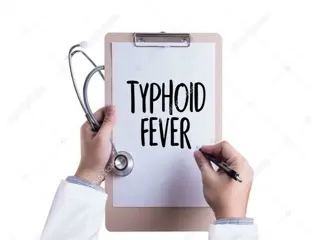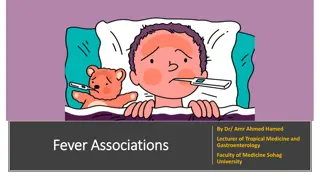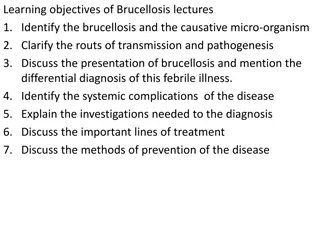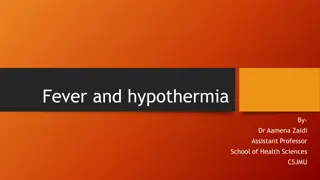
Fever: Causes, Classification, and Patterns
Learn about fever and its classification based on duration, height, and pattern. Discover the different types of fevers such as acute, chronic, remittent, intermittent, and periodic. Understand how fever is controlled in the body and the importance of monitoring body temperature for overall health.
Download Presentation

Please find below an Image/Link to download the presentation.
The content on the website is provided AS IS for your information and personal use only. It may not be sold, licensed, or shared on other websites without obtaining consent from the author. If you encounter any issues during the download, it is possible that the publisher has removed the file from their server.
You are allowed to download the files provided on this website for personal or commercial use, subject to the condition that they are used lawfully. All files are the property of their respective owners.
The content on the website is provided AS IS for your information and personal use only. It may not be sold, licensed, or shared on other websites without obtaining consent from the author.
E N D
Presentation Transcript
FEVER Body temperature is controlled in the hypothalamus,which is directly sensitive to changes in core Temperature. The normal 'set-point' of core temperature is tightly regulated within 37 0.5 C, as required to preserve normal function of many enzymes and other metabolic processes.
CLASSIFICATION OF FEVERS A) Based on Duration of Fever: 1. Acute fevers (<7 days): infectious diseases such as malaria and viral-related upper respiratory tract infection 2. Sub-acute fevers (usually not more than 2 weeks in duration): typhoid fever and intra-abdominal abscess 3. Chronic or persistent fevers (>2 weeks duration): chronic bacterial infections such as tuberculosis, viral infections like HIV, cancers and connective tissue diseases. However, any cause of acute fever can become persistent or chronic if untreated.
FEVER B) Based on Height of Fever: Normal and febrile body temperature ranges (rectal temperatures).
FEVER C) Based on Pattern of Fever: 1 Typhoid fever Drug fever Typhus Neoplasms
FEVER 2. Remittent Fever: Fever that oscillates more than 1 C or ~1.5 F ; doesnt touch normal Pattern of most fevers
FEVER 3. Intermittent Fever:
FEVER 4. Hectic or Septic Fever: When remittent or intermittent fever shows large variation between the peak and nadir Kawasaki disease Pyogenic infections
FEVER 5. Periodic or Cyclic Fever: Episodes of fever recurring at regular intervals Quotidian (24 hour periodicity): P. falciparum Double quotidian (12 hour periodicity): Kala-azar, Gonococcal arthritis, Juvenile RA, Some drug fevers (carbamazepine Tertian (48 hour periodicity): P. vivax, P. ovale Quartan (72 hour periodicity): P. malariae Pel-Ebstein Fever: bouts of fever lasting 3 to 10 days followed by asymptomatic periods of the same length (Hodgkin s disease) Relpasing fever (every 10-14 days): Borrelia recurrentis
FEVER Undulant fever : (gradual increase in temperature that remains high for a few days, and then gradually decreases to normal):Brucellosis
FEVER 6. Recurrent Fever: Illness involving the same organ (e.g. urinary tract) or multiple organ systems in which fever recurs at irregular interval: Familial Mediterranean Fever
GENERALISED APPROACH TO FEVER / FUO The approach to a patient presenting with fever of unknown origin (FUO) should include: a comprehensive history, physical examination and appropriate diagnostic testing
FEVER History: A comprehensive history should include questions about: A. The fever itself (e.g. route of measurement, peak temperature, patterns, time of day, etc.) B. Systemic symptoms (e.g. weight loss, decreased appetite, rash, myalgias, arthralgias, etc.) C. Localized symptoms (e.g. cough, urinary symptoms, headache, abdominal pain, bone pain, etc.) D. Travel history, sick contacts, animal contacts, family history, and sexual history E. Potential causes of drug-induced fever: diuretics, pain relievers, salicylates, anti- arrhythmic agents, anti-seizure drugs, sedatives, antihistamines, barbiturates, cephalosporins, penicillins, sulfonamides.






















